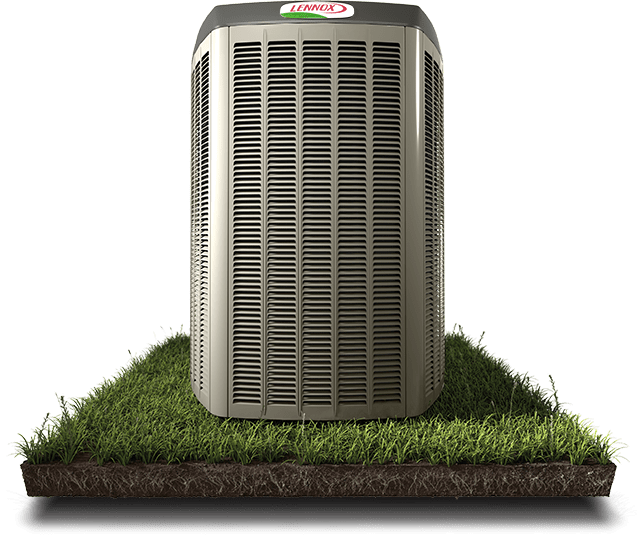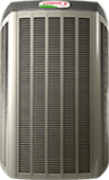xc21
Multi-Stage Air Conditioner
The most efficient two-stage central air conditioner you can buy

All Dave Lennox Signature® Collection models come with a 10-Year Limited Warranty on compressor and covered components. For more information, visit www.Lennox.com/WarrantyYourWay.
Cooling Savings
Features
Cooling that goes beyond temperature control
Humidity levels can drastically affect how the air in your home feels. It can make the air feel up to 8 degrees warmer than the actual temperature. By working with the Humiditrol® whole-home dehumidification system, the XC21 can preserve your comfort in every way.
An energy-smart decision you’ll appreciate every day
With efficiencies of up to 21.00 SEER, the XC21 can lower your energy bills by hundreds of dollars a year, while still keeping your home cool and quiet.
Leading the way in smart energy use
Advanced engineering in the XC21 means enjoying smart, energy-efficient comfort all year long. This product has been designated as one of the Most Efficient ENERGY STAR certified products in 2022. Products that are recognized as the Most Efficient of ENERGY STAR in 2022 prevent greenhouse gas emissions by meeting rigorous energy efficiency performance levels set by the U.S. Environmental Protection Agency.
Learn more about Lennox awards for innovative initiatives in product design.

You’ll hardly know it’s running
The XC21 uses SilentComfort™ technology to reduce operating noise, making it the quietest multi-stage air conditioner you can buy. Even when installed outside a bedroom window, it lets you rest peacefully.
Resources
Product Literature
FAQs
Glossary of terms
-
- Air Handler
- An air handler, or air handling unit, is the indoor part of an air conditioner or heat pump that moves cooled or heated air throughout the ductwork of your home. It is usually a large metal box containing important elements of an HVAC system that controls airflow and filtration. Lennox® air handlers are among the most efficient and quietest you can buy.
Learn More -
- Central Air-Conditioning
Developed in the 1960s, central air conditioning or central AC is the most common type of whole-home HVAC system used in the United States today. A central AC system’s job is to cool air in a central location and distribute it evenly throughout a home or other multi-room space. This centralization eliminates the complications of cooling each space separately while maximizing efficiency and comfort.
-
- Coil
Coils are the most important part of your HVAC (heating, ventilation and air conditioning) system. They make your home cool in the summer and warm in the winter. Understanding how your HVAC coils work and what to do to maintain them play a big role in saving you from a broken heat pump or air conditioner.
-
- Condenser
- A condenser (or AC condenser) is the outdoor portion of an air conditioner or heat pump that either releases or collects heat, depending on the time of the year.
Learn More -
- Decibel (dB)
- A decibel (dB) is a unit used to measure the relative intensity of sound. For example, sound levels in a library are normally about 40 dB, normal conversations range from about 50 to 60 dB, and an operating motorcycle or garbage truck can be as high as 100 dB.
Learn More -
- Dry-Charged Unit
- An air conditioner or heat pump that is shipped dry and charged with refrigerant at the place of installation. Dry-charged units are appropriate for homeowners who need a replacement unit compatible with R-22 refrigerant.
Learn More -
- Energy Star®
- ENERGY STAR® is a program of the U.S. Environmental Protection Agency (EPA) designed to help consumers and businesses save money by choosing energy-efficient products and technologies. Heating, ventilation and air-conditioning (HVAC) equipment with the ENERGY STAR® label meets or exceeds federal guidelines for energy-efficient performance.
Learn More -
- Evaporator Coils in HVAC Systems
What is an Evaporator Coil?
An evaporator coil is a vital component of an air conditioning system or heat pump that plays a central role in the cooling process. Located inside the air handler or attached to the furnace, it contains the refrigerant that absorbs heat from indoor air. As warm air from your home passes over the coil, the refrigerant inside the coil captures the heat, helping cool the air before it’s recirculated.
-
- Fan Coil Unit
- A fan coil unit (FCU) is a device that uses a coil and a fan to heat or cool a room without connecting to ductwork. Indoor air moves over the coil, which heats or cools the air before pushing it back out into the room. FCUs can be less expensive to install than ducted systems, and are available in ceiling, floor-mounted and freestanding configurations.
Learn More -
- Grid-Tie Inverter Solar System
- A grid-tie inverter solar system is the most common and least expensive of all residential solar systems. It allows homeowners to use their own solar-generated electricity to save energy and reduce costs. The utility company’s grid, or network of power stations, serves as the backup power source.
Learn More -
- HVAC Compressors: The Heart of a Cooling System
What Is an HVAC Compressor?
An HVAC compressor is a critical component of air conditioning systems and heat pumps. Housed in the outdoor unit, it plays a vital role by compressing and circulating refrigerant throughout the system. This allows your system to efficiently absorb heat from indoors and release it outdoors, or vice versa in the case of heat pumps during the heating season. -
- iComfort®–Enabled
- An iComfort®–enabled product is one that is designed to work with an iComfort® programmable thermostat as part of an advanced home comfort system. When you choose a heating, cooling or humidity control product that’s iComfort-enabled, you’re ensuring a higher level of home comfort and control.
Learn More -
- Indoor Coil
- See Evaporator Coil.
Learn More -
- Net Metering
- A service available from many utility providers in which homeowners get full retail value for most, if not all, of the electricity produced by their own generating system. A utility meter keeps track of the “net” difference between the electricity used from the utility provider and the electricity produced by the homeowner’s system.
Learn More -
- Off-Grid Or Off-The-Grid
- An off-grid or off-the-grid system is an electricity-generating system that operates independently from the utility grid, providing all of the electricity needed in the home, and is generally more expensive than grid-tied system ideal for homes located in remote areas without utility service, or where installing power lines would be extremely costly.
Learn More -
- Outdoor Coil
- See Condenser.
Learn More -
- R-22 Refrigerant
- The old standard for residential air conditioners, now being phased out by the U.S. EPA. Lennox offers dry-charged units for those who still have R-22 compatible systems.
Learn More -
- R-410A Refrigerant
R-410A, is a chlorine-free, hydrofluorocarbon (HFC) refrigerant originally developed as a more environmentally friendly replacement for R-22. R-410A was developed and patented in 1991 by Honeywell.
-
- Refrigerant
Refrigerant is the working fluid used in air conditioners, refrigeration, and heat pump systems. It is a chemical compound that changes temperature as it transitions between liquid and gas form – cooling as it vaporizes, and heating up as it condenses. It is this property that facilitated a system’s ability to heat and cool.
-
- Refrigerant Lines
- Two copper lines that connect the outdoor air conditioner or heat pump to the indoor evaporator coil.
Learn More -
- Scroll Compressor
- A specially designed compressor that works in a circular motion, as opposed to up-and-down piston action.
Learn More -
- SEER
Simply put, this rating measures how much energy a heating and cooling system uses to operate. Learn how you can use SEER and SEER2 ratings to increase efficiency – and savings – in your home.
-
- SilentComfort™ Outdoor Fan Motor
- Describes a motor with electronic sensor technology that helps optimize overall system performance while keeping sound levels low. Used in select Lennox® outdoor air conditioners or heat pump units.
Learn More -
- Two-Stage Operation
- Provides two levels of heating or cooling output for enhanced temperature control, energy efficiency and indoor air quality.
Learn More
- * Efficiency ratings established per AHRI’s test standard: ANSI/AHRI 210/240-2017 of two-stage central AC/HP equipment as published in AHRI (December 2019).
Proper sizing and installation of equipment is critical to achieve optimal performance. Split system air conditioners and heat pumps (excluding ductless systems) must be matched with appropriate coil components to meet ENERGY STAR criteria. Ask your contractor for details or visit www.energystar.gov.

